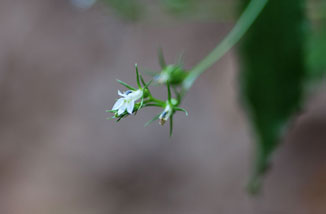INDIAN TOBACCO
|
 |
| File Size: 20 KB |
|
|
|
Lobelia inflata L.
|
| Wildcat Glades Conservation & Audubon Center, Newton County, Missouri |
| Annual |
| Height: 8-32 inches |
| Family: Campanulaceae - Bellflower Family |
| Flowering Period: July, August, September,October |
|
| Stems: | | Erect or ascending, usually branched above midpoint, narrowly winged, moderately or densely coarse-hairy or upper stem nearly glabrous. | | Leaves: | | Alternate, simple, sessile or with winged stalk to 1/4 inch long; lower stem leaves elliptic or oblong egg-shaped, 1.6 to 3.6 inches long, .75 to 1.4 inch wide; upper surface nearly glabrous or sparsely hairy; lower surface pubescent on veins; margins irregularly toothed to scalloped or nearly entire; tip pointed to blunt; base wedge-shaped or sometimes rounded; upper stem leaves gradually reduced, sessile. | | Inflorescences: | | Raceme, narrow, 1.2 to 8 inches long, loosely-flowereed, terminal on main stem and branches; 1 flower per node; bracts subtending each flower leaf-like, reduced upward. | | Flowers: | | Small, inconspicuous; calyx 1/8 to 2/5 inch long, glabrous; calyx lobes 5, linear, thread-like, tapering to points; corolla irregular, 1/4 to 1/3 inch long, white to pale blue or light purple, 5-lobed; upper lobes 2, lanceolate, erect or bent backward; lower lobes 3, oblong, bent downward, pubescent at base within; stamens 5, mostly fused into tube; hypanthium becomes much inflated as fruit matures. | | Fruits: | | Capsule, egg-shaped to ellipsoid, 1/4 to 2/5 inch long, 1/6 to 1/4 inch in diameter; seeds numerous, minute, orange to tan, narrowly ellipsoid. | | Habitat: | | Moist, open woods or disturbed areas, stream banks, pond and lake margins, old fields, roadsides; rich soils. | | Distribution: | | East 1/4 of Kansas | | Origin: | | Native | | Toxicity: | | Classified as poisonous by the Food and Drug Administration. | | Uses: | | In the past, was used medicinally as an antidepressant and to treat asthma and bronchitis and was used as a deterrent to smoking, but these uses have been abandoned due to its toxic properties. Native Americans steeped the roots and leaves to create a wash for sores and applied a root poultice to body aches and rubbed the leaves on stiff necks. The plant was smoked as a tobacco substitute, was used to treat bites and stings, and was utilized as a love charm. |
|
| Indian tobacco |  | | 74 KB | | Wildcat Glades Conservation & Audubon Center, Newton County, Missouri |
| | Indian tobacco |  | | 115 KB | | Wildcat Glades Conservation & Audubon Center, Newton County, Missouri |
| | Indian tobacco hypanthium |  | | 29 KB | | Wildcat Glades Conservation & Audubon Center, Newton County, Missouri |
| | Indian tobacco flower |  | | 20 KB | | Wildcat Glades Conservation & Audubon Center, Newton County, Missouri |
| | Indian tobacco leaf |  | | 53 KB | | Wildcat Glades Conservation & Audubon Center, Newton County, Missouri |
| | Indian tobacco stem |  | | 41 KB | | Wildcat Glades Conservation & Audubon Center, Newton County, Missouri |
| | | | |
|
|
|
|
|
|